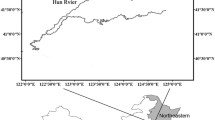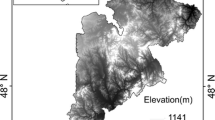Abstract
Dynamic zoning (systematic alteration in the spatial and temporal allocation of even-aged forest management practices) has been proposed as a means to change the spatial pattern of timber harvest across a landscape to maximize forest interior habitat while holding timber harvest levels constant. Simulation studies have established that dynamic zoning strategies produce larger tracts of interior, closed canopy forest, thus increasing the value of these landscapes for interior-dependent wildlife. We used the simulation model LANDIS to examine how the implementation of a dynamic zoning strategy would change trajectories of ecological succession in the Great Divide Ranger District of the Chequamegon–Nicolet National Forest in northern Wisconsin over 500 years. The components of dynamic zoning strategies (number of zones in a scenario and the length of the hiatus between successive entries into zones) and their interaction had highly significant impacts on patterns of forest succession. Dynamic zoning scenarios with more zones and shorter hiatus lengths increased the average amount of the forest dominated by early successional aspen (Populus sp.). Dynamic zoning scenarios with two zones produced more late successional mature northern hardwoods than scenarios with four zones. Dynamic zoning scenarios with very short (30 years) or very long (120 years) hiatus lengths resulted in more late successional mature northern hardwoods than scenarios with intermediate hiatus lengths (60 and 90 years). However, none of the dynamic scenarios produced as much late successional mature northern hardwoods as the static alternative. Furthermore, the amounts of all habitat types in all dynamic zoning scenarios fluctuated greatly in time and space relative to static alternatives, which could negatively impact wildlife species that require a stable amount of habitat above some minimum critical threshold. Indeed, implementing dynamic zoning scenarios of different designs would have both positive and negative effects on wildlife species and for other objectives of forest management.





Similar content being viewed by others
Literature Cited
C. D. Canham O. L. Loucks (1984) ArticleTitleCatastrophic windthrow in the presettlement forests of Wisconsin Ecology 65 IssueID3 803–809
J. A. Cardille S. J. Ventura M. G. Turner (2001) ArticleTitleEnvironmental and social factors influencing wildfires in the upper midwest, United States Ecological Applications 11 IssueID1 11–127
T. R. Crow (2002) Putting multiple use and sustained yield into a landscape context J. Liu W. W. Taylor (Eds) Integrating landscape ecology into natural resources management Cambridge University Press Cambridge
T. R. Crow E. J. Gustafson (1997) Ecosystem management: managing natural resources in time and space K. A. Kohm J. F. Franklin (Eds) Creating a forestry for the 21st century: the science of ecosystem Island Press Washington DC 215–228
D.R. Dessecker D.G. Mcauley (2001) ArticleTitleImportance of early successional habitat to ruffed grouse and American woodcock Wildlife Society Bulletin 29 456–465
DeZonia, B., and D. J. Mladenoff. APACK 2.22 user’s guide versions 5-6-02. 2002. Madison, WI, USA, Unpublished report, available at http://flel.forest.wisc.edu/projects/apack/
D.W. Einspahr G.W. Wyckoff (1990) ArticleTitleNorth American aspen: Timber supply, utilization, and research Northern Journal of Applied Forestry 7 168–171
D. J. Flaspohler S. A. Temple R. N. Rosenfield (2001) ArticleTitleSpecies-specific edge effects on nest success and breeding bird density in a forested landscape Ecological Applications 11 32–46
R. T. Forman M. Gordon (1986) Landscape ecology John Wiley & Sons New York
J.F. Franklin T.T. Forman (1987) ArticleTitleCreating landcape patterns by forest cutting: Ecological consequences and principles Landscape Ecology 1 IssueID1 5–18
R. H. Gardner E. J. Gustafson (2004) ArticleTitleSimulating dispersal of juvenile American martens in heterogeneous landscapes Ecological Modelling 171 339–358 Occurrence Handle10.1016/j.ecolmodel.2003.08.008
J. H. Gilbert J. L. Wright D. J. Lauten J. R. Probst (1997) Den and rest-site characteristics of American marten and fisher in northern Wisconsin G. Proulx H. N. Bryant and P. M. Woodard (Eds) Martes: Taxonomy, ecology, techniques, and management Provincial Museum of Alberta, Edmonton Alberta, Canada 135–145
E. J. Gustafson (1998) ArticleTitleClustering timber harvests and the effect of dynamic forest management policy on forest fragmentation Ecosystems 1 484–492 Occurrence Handle10.1007/s100219900044
E. J. Gustafson T. R. Crow (1994) ArticleTitleModeling the effects of forest harvesting on landscape structure and the spatial distribution of cowbird brood parasitism Landscape Ecology 9 IssueID4 237–248 Occurrence Handle10.1007/BF00129235
E. J. Gustafson T. R. Crow (1996) ArticleTitleSimulating the effects of alternative forest management strategies on landscape structure Journal of Environmental Management 46 77–94 Occurrence Handle10.1006/jema.1996.0008
E. J. Gustafson S. R. Shifley D. J. Mladenoff K. K. Nimerfro H. S. He (2000) ArticleTitleSpatial simulation of forest succession and timber harvesting using LANDIS Canadian Journal of Forest Research 30 32–43 Occurrence Handle10.1139/cjfr-30-1-32
E. J. Gustafson P. A. Zollner H. S. He B. R. Sturtevant D. J. Mladenoff (2004) ArticleTitleInfluence of forest management alternatives and land type on susceptibility to fire in Northern Wisconsin, USA Landscape Ecology 19 327–341 Occurrence Handle10.1023/B:LAND.0000030431.12912.7f
Hansen, M. H., T. Frieswyk, J. F. Glover, and J. F. Kelly. 1992. The Eastwide forest inventory data base: user’s manual. General. Technical Report NC-151. USDA Forest Service, Washington DC
H. S. He D. J. Mladenoff (1999) ArticleTitleSpatially explicit and stochastic simulation of forest landscape fire disturbance and succession Ecology 80 IssueID1 81–99
H. S. He D. J. Mladenoff J. Beoder (1999a) ArticleTitleObject-oriented design of a spatially explicit forest landscape model and the representation of species age classes Ecological Modelling 119 1–19 Occurrence Handle10.1016/S0304-3800(99)00041-1
H. S. He D. J. Mladenoff T. R. Crow (1999b) ArticleTitleLinking an ecosystem model and a landscape model to study forest species response to climate warming Ecological Modelling 112 213–233 Occurrence Handle10.1016/S0304-3800(98)00147-1
G. E. Host P. L. Polzer D. J. Mladenoff M. A. White T. R. Crow (1996) ArticleTitleA quantitative approach to developing regional ecosystem classifications Ecological Applications 6 IssueID2 608–618
J. E. Keys C. Carpenter S. Hooks F. Koenig W. H. McNab W. Russell M. L. Smith (1995) Ecological units in the eastern United States—First approximation USDA Forest Service Atlanta, Georgia
W. Klenner W. Kurz S. Beukema (2000) ArticleTitleHabitat patterns in forested landscapes: management practices and the uncertainty associated with natural disturbances Computers and Electronics in Agriculture 27 243–262 Occurrence Handle10.1016/S0168-1699(00)00110-1
G. M. Koehler J. A. Blakeskey T. W. Koehler (1990) ArticleTitleMarten use of successional forest stages during winter in north-central Washington Northwestern Naturalist 71 1–4
W. A. Kurz S. J. Beukema W. Klenner J. A. Greenough D. C. E. Robinson A. D. Sharpe T. M. Webb (2000) ArticleTitleTELSA: The tool for exploratory landscape scenario analyses Computers and Electronics in Agriculture 27 227–242 Occurrence Handle10.1016/S0168-1699(00)00109-5
P. B. Landres P. Morgan F. J. Swanson (1999) ArticleTitleOverview of the use of natural variability concepts in managing ecological systems Ecological Applications 9 IssueID4 1179–1188
H. Li J. F. Franklin F. J. Swanson T.A. Spies (1993) ArticleTitleDeveloping alternative forest cutting patterns: A simulation approach Landscape Ecology 8 IssueID1 63–75 Occurrence Handle10.1007/BF00129867
J. C. Manolis D. E. Andersen F. J. Cuthbert (2000) ArticleTitlePatterns in clearcut edge and fragmentation effect studies in northern hardwood–conifer landscapes: Retrospective power analysis and Minnesota results Wildlife Society Bulletin 28 IssueID4 1088–1101
B. G. Marcot D. D. Murphy (1996) On population viability analysis and management R. C. Szaro and D. W. Johnston (Eds) Biodiversity in managed landscapes Oxford University Press New York 58–76
J. Mickman (2002) Balsam bough and wreath industry in Minnesota M. Reichenbach J. Krantz K. Preece (Eds) Non-timber forest products and implications for forest managers University of Minnesota Extension Service St. Paul, Minnesota
D. J. Mladenoff H. S. He (1999) Design, behavior and application of LANDIS, and object-oriented model of forest landscape disturbance and succession D. J. Mladenoff W. L. Baker (Eds) Spatial modeling of forest landscape change: approaches and applications Cambridge University Press Cambridge 125–162
D. J. Mladenoff J. Pastor (1993) Sustainable forest ecosystems in the northern hardwood and conifer forest region: Concepts and management G. H. Aplet N. Johnson J. T. Olson V. A. Sample (Eds) Defining sustainable forestry Island Press Washington, DC 144–179
D. J. Mladenoff M. A. White T. R. Crow J. Pastor (1994) ArticleTitleApplying principles of landscape design and management to integrate old-growth forest enhancement and commodity use Conservation Biology 8 IssueID3 752–762 Occurrence Handle10.1046/j.1523-1739.1994.08030752.x
K. Ohman L. O. Eriksson (1998) ArticleTitleThe core area concept in forming contiguous areas for long-term forest planning Canadian Journal of Forestry Research 28 1032–1039 Occurrence Handle10.1139/cjfr-28-7-1032
J. Pastor W. M. Post (1986) ArticleTitleInfluence of climate, soil moisture, and succession on forest carbon and nitrogen cycles Biogeochemistry 2 3–27
InstitutionalAuthorNameSAS (1988) SAS user’s guide SAS Institute Inc. Cary, North Carolina
B. R. Sturtevant J. A. Bissonette J. N. Long (1996) ArticleTitleTemporal and spatial dynamics of boreal forest structure in western Newfoundland: Silvicultural implications for marten habitat management Forest Ecology and Management 87 13–25 Occurrence Handle10.1016/S0378-1127(96)03837-6
B. R. Sturtevant P. A. Zollner E. J. Gustafson D. T. Cleland (2004) ArticleTitleHuman influence on fuel connectivity and risk of catastrophic fires in mixed forests of northern Wisconsin Landscape Ecology 19 235–253 Occurrence Handle10.1023/B:LAND.0000030420.87498.f7
F. R. I. Thompson W. D. Dijak T. G. Kulowiec D. A. Hamilton (1992) ArticleTitleBreeding bird populations in Missouri Ozark forests with and without clearcutting Journal of Wildlife Management 56 23–30
D. O. Wallin F. J. Swanson B. Marks (1994) ArticleTitleLandscape pattern response to changes in pattern generation rules: land-use legacies in forestry Ecological Applications 4 IssueID3 569–580
P. T. Wolter D. J. Mladenoff G. E. Host T. R. Crow (1995) ArticleTitleImproved forest classification in the northern lake states using multi-temporal Landsat imagery Photogrammetric Engineering and Remote Sensing 61 IssueID9 1129–1143
Wright, J. 1999. Winter home range and habitat use by sympatric fishers (Martes pennanti) and American martens (Martes americana) in Northern Wisconsin. M.S. thesis. University of Wisconsin, Stevens Point, Wisconsin, pp 73
J. H. Zar (1999) Biostastical analysis Prentice-Hall Upper Saddle River, New Jersey
Acknowledgments
Kevin Nimerfro, Jason McKeefry, Luke Rasmussen, and John Wright provided invaluable technical support with LANDIS. Mark Theisen, Phil Freeman, Linda Parker, and Terry Strong helped us refine the model parameters so the simulation more closely resembled silvicultural activities on the Great Divide Ranger District. Brian Sturtevant and Jay Roberts helped shape our thinking on data analysis. Brian Sturtevant, Tom Crow, and Steve Shifley provided helpful comments on this manuscript.
Author information
Authors and Affiliations
Corresponding author
Rights and permissions
About this article
Cite this article
Zollner, P.A., Gustafson, E.J., He, H.S. et al. Modeling the Influence of Dynamic Zoning of Forest Harvesting on Ecological Succession in a Northern Hardwoods Landscape. Environmental Management 35, 410–425 (2005). https://doi.org/10.1007/s00267-003-0217-9
Published:
Issue Date:
DOI: https://doi.org/10.1007/s00267-003-0217-9




